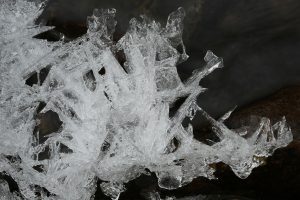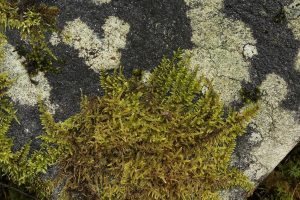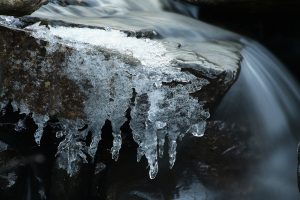
A couple of weeks after my last visit to the Red Burn on Dundreggan I was back there again for another day of photography. The weather had been unseasonably cloudless and warm during the previous week, but there had been hard frosts at night, so the ground was frozen. There was no snow anywhere to be seen on the lower slopes of the estate, which was unusual after such a run of freezing nights, but when I reached the Red Burn I was delighted to see some beautiful ice formations lining its banks in many places.


It was cloudy the day I was there, but even in the absence of the sun, the ice was melting as I watched, so I suspected there must have been much more of it just a day or two before. As on my previous visit, I had been planning on walking up the burn for some distance, but I soon gave up on that idea as I realised there were so many beautiful patches of ice on the lower section of the burn!


The melting of the ice was creating some wonderful fractal shapes, with irregular jagged edges and Rorschach-like holes in them, and the steady drip of water from the ice patches seemed like a slow motion version of the flow in the main part of the burn …


In one large patch, the ice had formed in linear, geometrical shapes at irregular angles to each other, which created interesting visual patterns.

As I marvelled at the complex shapes of the ice, I realised that all of these patches had been created from spray coming off the burn itself. There had been no snow at all, and there wasn’t any ice on the surrounding land, so it was obvious that these patches must have accumulated gradually over a period of several nights of sub-zero temperatures. The spray must have frozen in place where it landed, and I could imagine how the ice formations had slowly increased, giving rise to the geometric shapes that I saw.

The pattern of interconnected linear pieces of ice also reminded me somehow of the underground network of hyphae – the white filaments that are the main part of fungi (the mushrooms we see in late summer and early autumn are just the fruiting bodies of the fungi). I suspected that this ice had considerable structural strength, echoing the resilience and strength that fungi bring to forest ecosystems, through the mycorrhizal relationships that are formed from the interweaving of the hyphae with the roots of the trees …


As I walked downstream from one patch of ice towards another, I noticed a boulder near the burn that had a distinctive grouping of lichen patches on it. The pattern they made was quite different to that of the ice in the burn, but both seemed to reflect the growth of organic forms in Nature, but over different timescales. While the ice shapes formed in a matter of days or hours even, the lichen patches would have been slowly growing for years or possibly decades to reach the size they were now.

A little further downstream, a small tree, probably an alder (Alnus glutinosa), had died and fallen across the burn. It had several parallel stems and must have been in the burn for some time, as all the bark had been stripped off them by the flowing water. The lower-most of these stems had a line of large icicles hanging down from it, and the bottoms of those were almost touching the water. Again, it was clear to see that these icicles must have accumulated here from drops of spray that had hit the stems and frozen in place there.

Over a period of time, they must have grown organically, just like stalagmites in a cave, as more and more drops of spray froze on to the icicles that had already formed. Some of the icicles were thicker and longer than others, so I supposed that they must have been in the path of a greater amount of spray. As I watched I could see a steady drip of water from the icicles, indicating they were melting. I guessed that over the previous few days, when it had been freezing at night but warm and sunny during the days, they had alternated between growing larger each night and melting during the days …


Heading upstream again, I came to another area with some small cascades, and there were more ice formations there, coating the rocks and some small branches that had fallen at the edge of the burn. It was very obvious that the sections of the burn with cascades had the most ice, as there was much more spray produced there than on the slow-moving, flat sections of water.



Many of the ice formations were quite abstract, and their shapes seemed to be frozen echoes of the movement of the water in the cascades …



On one of the rocks there were some more icicles. Unlike the relative uniformity of shapes in those I had seen earlier, these ones had a variety of forms, and I guessed this was due to an irregular flow of water over the rock they were on.

I really like the way that light is reflected off of natural ice formations, and the complex shapes of these icicles seemed to accentuate and amplify this effect. The water behind the icicles was very dark, being in the shade under the rock, and the contrast this made with the icicles also helped to emphasise the play of light on the different surfaces of the ice. This too was a transient beauty though, and I suspect that the ice would have melted completely in the next day or so …



By now, the light was beginning to fade, and it was time to head for home. However, there was a good specimen of a birch polypore fungus (Piptoporus betulinus) on a fallen birch tree near the burn there, so it was the subject of my final photographs for the day. Along the way, in between taking photographs of the ice formations, I shot some video footage as well, and seeing the water flowing in that provides an interesting comparison with the blurred motion of the water in the still images.
[jwplayer config=”alan29may” file=”http://www.alansblog.org.uk/alan-26-feb.mp4″ html5_file=”http://www.alansblog.org.uk/alan-26-feb.mp4″ image=”http://www.alansblog.org.uk/alan-26-feb-preview.jpg”]
Hi Alan,
Great pictures!! I am always so enthusiastic about Scotland , great country , the only thing is not enough trees .. but you are going to change this.. I know about you from my friend , Dorothea . She used to live in Scotland , Edinburgh and at various occasions visiting the Highlands.. always great experiences!! Now I am going to tell her about your great photographs..I m sure she `ll be happy seeing them. Now all the best and good continuation.
Martin ( you can find me on facebook)
Hi Martin,
Many thanks for your message and the positive comments about my blog and photographs. I hope you get a chance to visit the Caledonian Forest yourself at some point.
With best wishes,
Alan